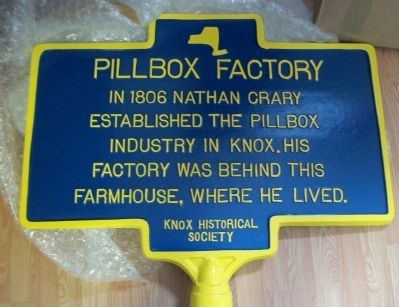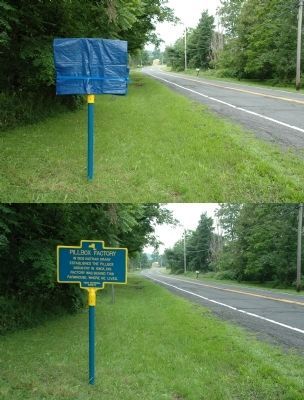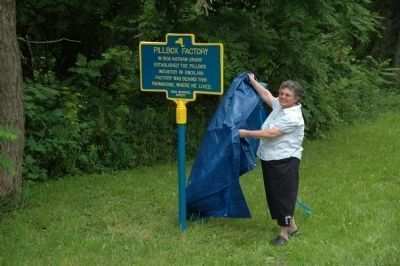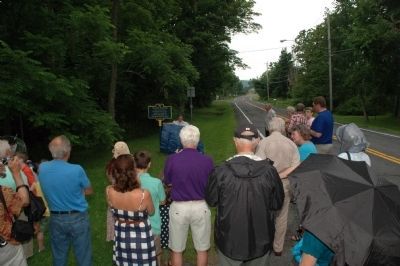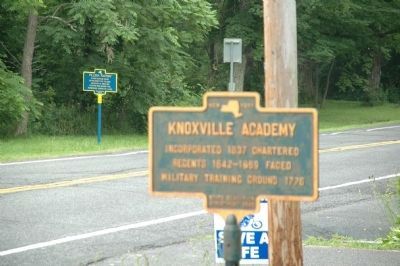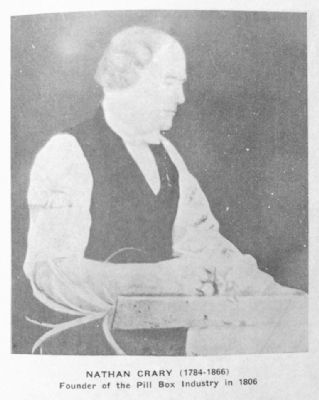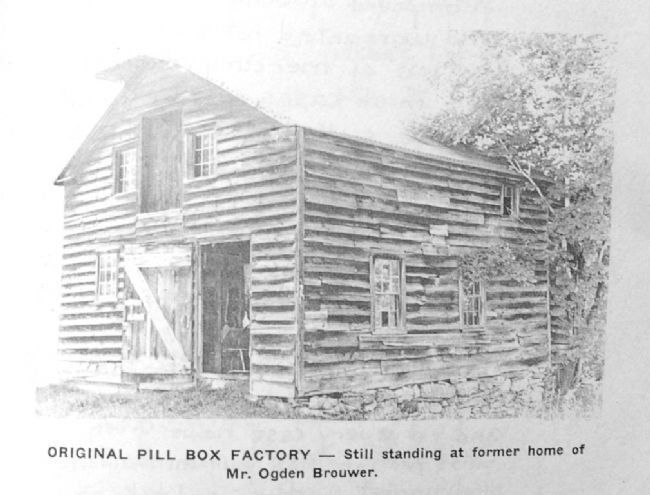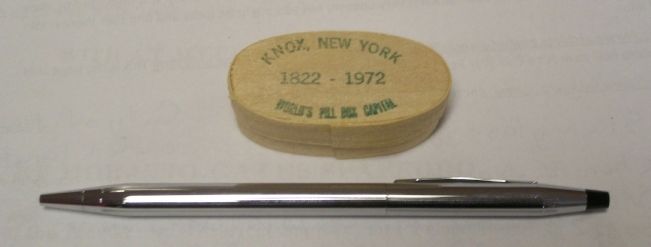Knox in Albany County, New York — The American Northeast (Mid-Atlantic)
Pillbox Factory
In 1806 Nathan Crary established the pillbox industry in Knox. His factory was behind this farmhouse, where he lived.
Erected 2014 by Knox Historical Society.
Topics. This historical marker is listed in these topic lists: Industry & Commerce • Science & Medicine. A significant historical year for this entry is 1806.
Location. 42° 40.079′ N, 74° 7.246′ W. Marker is in Knox, New York, in Albany County. Marker can be reached from Berne-Altamont Road (New York State Route 156), on the right when traveling east. Touch for map. Marker is at or near this postal address: 2223 Berne Altamont Road, Knox NY 12107, United States of America. Touch for directions.
Other nearby markers. At least 8 other markers are within 3 miles of this marker, measured as the crow flies. Knoxville Academy (within shouting distance of this marker); Town of Knox (approx. 0.2 miles away); Town of Knox War Memorial (approx. 0.2 miles away); Palatine Trail (approx. ¾ mile away); Sand Farm (approx. 0.8 miles away); Anti-Rent Riots (approx. 2.3 miles away); Earliest House (approx. 2½ miles away); Pioneer (approx. 2½ miles away). Touch for a list and map of all markers in Knox.
Regarding Pillbox Factory.
The following is taken from a presentation by Miss Leslie W. Brower and Mr. Arthur Quay at the Annual Meeting of the Early American Industries Association at the Albany Institute of History and Art on October 14, 1939, as reported in the Association’s 1940 newsletter, The Chronicle. The relevant portion of The Chronicle was attached to Mr. Ogden Brower’s June 1, 1955 letter to Mr. Albert B. Corey, NYS Historian, requesting that a historic marker be placed at the site of Nathan Crary’s pill box factory (at Ogden Brower’s farmhouse). The letter and attachments are preserved at the NYS Museum.
Nathan Crary organized the Knox pill box industry in 1806. According to Miss Brower, the industry continued until 1906 (however, her brother, Ogden Brower argues in his letter, based on reliable authority, that wooden pill boxes were still made in Knox in 1926).
The boxes were made from basswood, and were made nowhere else in the country or the world. Three families were prominent in the manufacture of the boxes: the Crarys, the Quays and the Champions. Aside from these concentrated groups, work was “lent out” to women in nearly all the homes in the hamlet. When completed the boxes were packed in “tierces” of over 10,000 boxes. The average daily product of one pair of hands was from 1600 to 1800 boxes.
The boxes were used for various “cure-alls” such as Sherman’s Cathartic Lozenges, Dr. Newton’s Jaundice Bitters, etc. One patent medicine company used more
than 1,000,000 boxes a year.
Miss Brower reports that life in the little Town of Knox was primitive in the early 1800’s. “It was heavily wooded with narrow dirt roads, full of stones over which wagon wheels would glance and slide down, with steep ascents and declines where squeaky brakes would be applied. Imagine stepping to one side to let a hay-rick rumble by, piled to the ridge poles with tierces, filled with wooden pill boxes and bound, not for Albany, but for Rensselaer by ferry boat to the freight office and hence down the Hudson. These were pioneer days and this a pioneer industry. The invention of machinery to turn out glass vials and tin boxes and the scarcity of basswood trees were the chief causes for the end of the industry.”
According to Arthur Quay, the best basswood trees in the forest were selected, and a large chip was chopped from the base of the tree to see whether or not the wood would split freely, as straight-grained timber was especially required. The trees were sawed by hand into blocks, and the blocks were then split into four, six or eight pieces, depending on the size of the blocks. After splitting, the timber was allowed to dry or “cure.” For many years, the shavings known as the “winding” or “hoop” shavings, which formed the sides of the boxes, and the heavier shavings known as “stamp” shavings, from which the tops and the bottoms
of the boxes were made, were cut by hand. Later, this work was done by horse power.
Daniel A. Driscoll
April 28, 2014
Also see . . .
1. Pillboxes put Knox on the 19th-century map. Welcome to the Hilltowns website entry (Submitted on July 15, 2014, by Howard C. Ohlhous of Duanesburg, New York.)
2. 1994 Town of Knox Comprehensive Plan: Pill Box Manufacturing. Welcome to the Hilltowns website entry (Submitted on July 15, 2014, by Howard C. Ohlhous of Duanesburg, New York.)
Additional keywords. Pill Box Factory Pillbox Capital Pill Box Capital Daniel A. Driscoll Daniel Driscoll Dan Driscoll
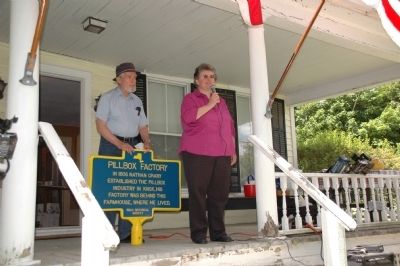
Photographed By Howard C. Ohlhous, June 21, 2014
5. Pillbox Factory Marker
Daniel A. Driscoll, a Trustee of the Knox Historical Society, holds the Pillbox marker for display during a recent Knox Historical Society event at the Saddlemire Homestead Museum, with Knox Historical Society President, Nancy Frueh, prior to the markers installation.
Credits. This page was last revised on June 6, 2022. It was originally submitted on May 10, 2014, by Howard C. Ohlhous of Duanesburg, New York. This page has been viewed 717 times since then and 29 times this year. Photos: 1. submitted on May 10, 2014, by Howard C. Ohlhous of Duanesburg, New York. 2, 3, 4, 5, 6, 7. submitted on July 15, 2014, by Howard C. Ohlhous of Duanesburg, New York. 8, 9. submitted on May 10, 2014, by Howard C. Ohlhous of Duanesburg, New York. • J. J. Prats was the editor who published this page.
